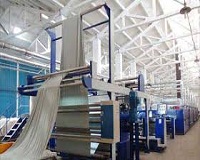"Automation has been making inroads in the textile industry rapidly owing to increasing competition, rising labour costs and lack of skilled workforce. While the industry has started taking steps, it has yet to catch up with the global counterparts. Deploying automation has multiple advantages such as eliminating human operators from a specific job, creating new jobs through operation and maintenance of automatic tools and equipment. The transition doesn’t seem to be easy either as the manufacturer also needs to reduce production cost to survive in the competitive market."
 Automation has been making inroads in the textile industry rapidly owing to increasing competition, rising labour costs and lack of skilled workforce. While the industry has started taking steps, it has yet to catch up with the global counterparts. Deploying automation has multiple advantages such as eliminating human operators from a specific job, creating new jobs through operation and maintenance of automatic tools and equipment. The transition doesn’t seem to be easy either as the manufacturer also needs to reduce production cost to survive in the competitive market.
Automation has been making inroads in the textile industry rapidly owing to increasing competition, rising labour costs and lack of skilled workforce. While the industry has started taking steps, it has yet to catch up with the global counterparts. Deploying automation has multiple advantages such as eliminating human operators from a specific job, creating new jobs through operation and maintenance of automatic tools and equipment. The transition doesn’t seem to be easy either as the manufacturer also needs to reduce production cost to survive in the competitive market.
Till a few years back, buttonholing machines, button attaching machines, bar tacking machines, label attaching machines and pocket sewing machines were the widely accepted technologies. But advancements such as computeraided design (CAD) and computeraided manufacturing (CAM) applications, new techniques in cutting, fusing, and pressing, as well as application of robotics has revolutionised the sector. The clothing industry has thus been transformed from a traditional, labour-intensive one into a highly automated and computer-aided industry.
The need for automation
Consumers are asking for garments with very complex design as per changing tastes. There is no traditional season cycles followed by retailers today due to fast changing customer demands. So buyers give multiple smaller orders that are less in quantity. With the fashion cycles becoming smaller and smaller, different styles are introduced quickly. To move with the market and satisfy the changing customers’ needs, the buyers have reduced manufacturing lead time. With consumers becoming quality conscious, the need for automation has grown further. Moreover, today a buyer is looking for a manufacturer who can provide complete solution for their design line. For example, a manufacturer who can produce trousers, shirts, kids wear, etc., will be a preferred by the buyer.
season cycles followed by retailers today due to fast changing customer demands. So buyers give multiple smaller orders that are less in quantity. With the fashion cycles becoming smaller and smaller, different styles are introduced quickly. To move with the market and satisfy the changing customers’ needs, the buyers have reduced manufacturing lead time. With consumers becoming quality conscious, the need for automation has grown further. Moreover, today a buyer is looking for a manufacturer who can provide complete solution for their design line. For example, a manufacturer who can produce trousers, shirts, kids wear, etc., will be a preferred by the buyer.
The production capacity of an apparel manufacturer plays a big role in the decision of implementation automatic and advanced technologies. Although smaller units offer advantages such as operational speed, flexibility, and adaptability, automation is not a favourable option for them due to low volume of production. On the other hand, larger manufacturing units adopt automation techniques more easily as high volume of production compensates for the additional cost of installing such equipment.
Often, the style and design of the garment to be manufactured influences the level of adoption of advanced technologies. For example, a garment manufacturer producing men’s shirts can adapt automatic equipment for the attachment of cuffs and collars, which are readily available now at competitive prices. A manufacturer‘s success in adopting automated technologies is highly dependent on the company‘s planned budget for investing in such technologies. The company will also need to set aside a portion of the budget for installation, training, operation and maintenance of the machinery.
Recent innovations
In line with changing market dynamics, companies have come up with various automation solutions to garner growth. TUKA3D‘s accurate virtual fit sessions with animation allows the user to bypass physical sample making, dramatically reducing the time and cost associated with product development. Tukatech’s 3D apparel design software eliminates the need for trial and error in physical sample creation, ensuring that any design fits right the first time. Its virtual fit sessions with animation allows the user to bypass physical sample making, dramatically reducing the time and cost associated with product development, so crucial in a time conscious world. It can be used to animate the virtual fit model to visualise how a garment drapes in motion.
Similarly, Turkey-based group Robotech, which is known for bringing latest and highly technical automatic machines, offers many automatic solutions. The automatic pocket welting machine FF 6100-TR; XP 7100 – IX polo fly automat, which can increase the productivity by around the 20 per cent and JK 9300 – IX for automation in making waist bands. The sewing unit for piped pockets in FF 6100-TR allows an efficient and flexible production of straight and optionally slanted welt pockets, flap pockets and inside pockets for the production of men’s and ladies jackets, coats, blazers, anoraks and trousers on a maximum quality level. Another machine XP 7100 - IX automatic placket setting workstation can fully automatise a series of sewing placket processes. The machines can be used with Brother Direct Drive sewing head; Beijer electronics windows Based 256 Million Colour supported touch screen control Panel. It comes with programmable start and end back tack or optionally adjustable stitch condensing.












